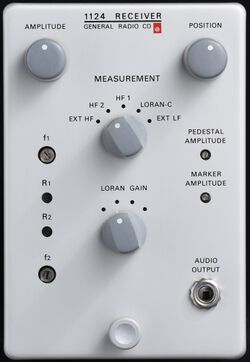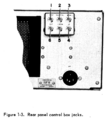1124: Difference between revisions
No edit summary |
No edit summary |
||
| (2 intermediate revisions by the same user not shown) | |||
| Line 8: | Line 8: | ||
|series= | |series= | ||
|introduced=1968 | |introduced=1968 | ||
|discontinued= | |discontinued=(?) | ||
|designers= | |designers= | ||
|manuals= | |manuals= | ||
* [[Media:General Radio 1124-0100-A Jan 1969.pdf|General Radio 1124-0100-A | * [[Media:General Radio 1124-0100-A Jan 1969.pdf|General Radio 1124-0100-A Manual, 1969]] | ||
{{Catalog History}} | {{Catalog History}} | ||
}} | }} | ||
The {{Title|General Radio 1124}} was available in {{catalog T}} only. It is part of a | The {{Title|General Radio 1124}} was available in {{catalog T}} only. It is part of a time broadcast receiver system consisting of a modified [[tekwiki:RM564|Tektronix RM564 storage oscilloscope mainframe]] with a [[tekwiki:2B67|Tektronix 2B67 time base]], and a GenRad-made receiver plug-in. Antenna connections to the receiver are routed through the rear of the modified oscilloscope mainframe. | ||
The instrument came with five receiver circuit boards for RF frequencies of 2.5, 3.33, 5.0, 7.335, and 10 MHz, respectively, any two of which could be installed in the receiver module at the same time, in addition to a Loran-C (100 kHz) receiver board and an IF amplifier board that occupy two more sockets. | The instrument came with five receiver circuit boards for RF frequencies of 2.5, 3.33, 5.0, 7.335, and 10 MHz, respectively, any two of which could be installed in the receiver module at the same time, in addition to a Loran-C (100 kHz) receiver board and an IF amplifier board that occupy two more sockets permanently. | ||
The 1124 is designed to work with a [[1123-A|GR 1123-A Digital Syncronometer]] (a time comparator with a 6-digit | The 1124 is designed to work with a [[1123-A|GR 1123-A Digital Syncronometer]] (a time comparator with a 6-digit "[[Numerik]]" clock display) and a [[1115-B|GR 1115-B 5 MHz/1 MHz/100 kHz Standard Frequency Oscillator]] based on an OCXO. | ||
The oscilloscope is used to align reference pulses produced by the 1123 with the received signal. | The oscilloscope is used to align reference pulses produced by the 1123 with the received signal. | ||
Latest revision as of 15:27, 5 November 2024
The General Radio 1124 was available in Catalog T (1968) only. It is part of a time broadcast receiver system consisting of a modified Tektronix RM564 storage oscilloscope mainframe with a Tektronix 2B67 time base, and a GenRad-made receiver plug-in. Antenna connections to the receiver are routed through the rear of the modified oscilloscope mainframe.
The instrument came with five receiver circuit boards for RF frequencies of 2.5, 3.33, 5.0, 7.335, and 10 MHz, respectively, any two of which could be installed in the receiver module at the same time, in addition to a Loran-C (100 kHz) receiver board and an IF amplifier board that occupy two more sockets permanently.
The 1124 is designed to work with a GR 1123-A Digital Syncronometer (a time comparator with a 6-digit "Numerik" clock display) and a GR 1115-B 5 MHz/1 MHz/100 kHz Standard Frequency Oscillator based on an OCXO.
The oscilloscope is used to align reference pulses produced by the 1123 with the received signal.
Specifications
- Frequencies: RF: 2.5, 3.33, 5.0, 7.335, and 10 MHz, any two selectable by front-panel switch; LORAN-C: 100 kHz
- Sensitivity: Better than 3 μV
- Input: 50 Ω, max. 100 mV
- Notch Filters: Two, front-panel screwdriver-control, 80 to 95 kHz and 105 to 125 kHz (other ranges with internal capacitor change)
Links
Photos
-
-
-
-
-
-
-
-
-
-
Modified rear panel of Tektronix RM564 oscilloscope, provided by GenRad as part of 1124 receiver setup










